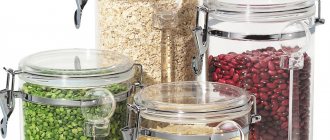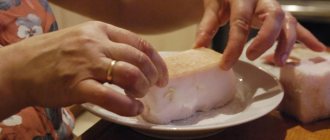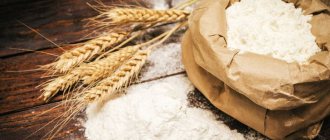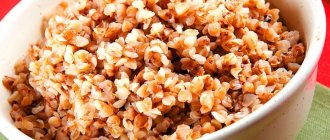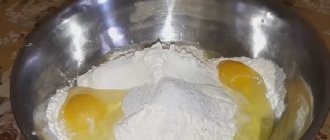Where do insects come from?
Pests can settle in bulk products for three reasons.
- Uncleanliness of the housewife. Unsanitary conditions in the kitchen are the least likely cause of “uninvited guests.” Even if you do general cleaning every day, you cannot be guaranteed to protect yourself from pests: insects can be brought into the house along with purchases from the store.
- Dishonesty of suppliers. Factories do not always comply with sanitary control requirements: storage conditions are often violated, and products do not undergo the necessary heat treatment. As a result, the housewife buys cereals that already contain pests.
- "Dangerous neighborhood." Insects can “immigrate” into cereals from nearby stocks of tea, herbs, pasta, dried fruits, and seasonings purchased by weight.
Is it possible to eat this cereal?
If you find cereal that has bugs in it, don’t even think about whether it can be used, but throw it away immediately. Contaminated products contain the remains of chitinous shells, excrement, and various forms of insect development. Bacteria and fungi settle in such cereals and find an environment for development.
The remains of shells covered with bristles are not digested in the digestive tract of humans and can cause irritation and inflammation of the stomach. Guanine and scleroproteins that are part of tick waste are not absorbed by any organism. In grain affected by pests, uric acid is formed in large quantities, which can cause a number of diseases in humans.
If there are bugs in rice, buckwheat, oatmeal or any other cereal, do not use it. Damage to the body is not detected immediately after eating spoiled cereals. The process of undermining is hidden, cumulative and gradual. As a result of such nutrition, amino acid metabolism in the body is disrupted, the number of red blood cells and hemoglobin in the blood decreases, which leads to lethargy, weakness, and sometimes more serious consequences. Therefore, if there are bugs in the cereal, then it is better to get rid of it than to have health problems. The same applies to flour.
Theoretically, flour containing bugs can be used, but is it worth it? No matter how you sift it, there will still be excrement in it. For example, flour damaged by the Moorish booger darkens, acquires an unpleasant odor and becomes unsuitable for use in cooking. If you make dough from such flour, it will not rise well and the bread will turn out low and soggy.
What are these pests and how dangerous are they?
Let's get to know pests better and find out which bugs most often “settle” in dry cereals.
Small flour beetles
Reddish-brown long bugs (3-3.5 mm) with wings, short antennae and rounded sides. Pests like buckwheat, semolina, flour, dried fruits, and millet. Flour bugs need to be dealt with immediately: eating foods with insects can cause stomach disorders, poisoning, and allergic reactions.
Small beetles reproduce at an astonishing rate: pests produce up to four generations of offspring per year. Mealworms are the larvae of this pest.
Surinamese mucoeds
Red beetles with long mustaches, whose body has a saw-tooth shape and is lined with short silky hairs. The length of insects is 1.5-2.5 mm. Typically, mealworms find refuge in rotten flour, corn grits, and loose pet food. Bulk products with a moisture content of less than 15-17% are not afraid of such pests.
One of the characteristic signs of “infestation” with red pests is a sieve for sifting flour chewed to holes. Con, insects increase the humidity of the cereals, littering the reserves with excrement and shells of larvae.
Bread grinders
Brown or red-brown bugs are cylindrical in shape, 1.8-3.7 mm long, the body of which is covered with hairs. Pests are unpretentious when it comes to food. Cereals and grains, tea and coffee, dried herbs, crackers, cookies, pet food, nuts and dried fruits - voracious insects are not averse to eating all of this.
The waste products of grinders are hazardous to health. Even if you manage to remove the insects from their grains, eating the spoiled product is strictly contraindicated.
If the number of insects is small, you may not even notice their presence - they do not crawl out. But if the density of their “population” is high, waste products and dead insects are found in herbariums, book bindings, even on walls and window sills.
Rice weevils (elephants)
Dark brown or almost black beetles with underdeveloped wings, body length - up to 4 mm. Most often, the pest settles in pasta, rice, barley grains, millet and rye, and flour. The waste products of pests and larvae are toxic, therefore, if even one beetle is found in the products, they can no longer be eaten.
food moth
A gray moth, the body length can reach 1 cm. The moth part is found in dried herbs, cereals, sugar and flour. Food moths, feeding on food supplies, contaminate them with excrement and remains of shells.
When asked whether bugs in cereals are dangerous for humans, experts answer in the affirmative, so if insects are detected, you must immediately begin fighting them.
What types of beetles grow in kupas
If pests are found in cereals, it is necessary to immediately begin combating them. First you need to determine what type of beetles has settled in the cereals, otherwise the fight may be ineffective.
As a rule, bulk products infect the following types of insects:
- Mukoed . This is a small pest, distinguished by a light brown tint. The pest belongs to the order Coleoptera and prefers such objects as granaries, mills, etc. for its life activity. Therefore, we can safely assume that the pest enters a person’s home with store-bought products. This parasite lives for about 3 years. During this time, the female lays about 300 eggs. If living conditions are favorable, the pest multiplies many times faster.
- Bread grinder . The insect is distinguished by a light brown tint and grows up to 3 mm in length. Prefers objects such as warehouses, confectionery shops, bakeries, etc. Can eat any baked goods, including crackers.
- Food moth . This is not a large butterfly, up to 1 cm long. The insect lives for about 2 weeks, but during this period the butterfly is capable of laying up to 400 eggs, which quite quickly turn into butterflies, which lay eggs. Soon after this they die.
- Rufous mucoed . This is a red-colored insect, up to 2 mm long. The pest feeds not only on flour products, but also on spoiled bulk food products.
- Flour beetle . It reaches a length of up to 4 mm and is distinguished by a reddish-brown tint. It can be found in kitchen cabinets where cereals are stored, as well as in bags of bulk food.
Some of the pests can fly, so they can easily get into the apartment from the street. To protect your home from many insects, it is better to install nets with small cells on windows and vents.
story Bugs in the cereal 20 02 14
How to get rid of bugs in cereals
It is worth removing beetles from cereals only if there are few insects. If pests have abundantly colonized bulk products, no traditional methods will help. Insects lay eggs in cereals, which are almost impossible to notice with the naked eye. There may also be colorless bugs - larvae - in the reserves.
However, even the elimination of contaminated food, judging by reviews, does not always guarantee freedom from unpleasant “neighbors.” But you can try by performing three consecutive steps.
- Screening. Armed with a sieve, sift the flour and carefully sort the cereal.
- Calcination. Calcine the product in an oven preheated to 100-110°C.
- Washing. Immediately before use, soak the cereal in a salt solution, then rinse thoroughly in running water.
There is only one way to effectively get rid of insects in cereals: throw away all products in which insects are found and carry out a thorough disinfestation.
Working folk methods: which ones to choose?
Those who consider chemicals too dangerous and the disposal and destruction of insects by lowering or raising temperatures are not so effective should try to solve the problem with the help of folk remedies. Recipes for some of them are below:
- Table vinegar. All surfaces infected with the bug are treated with a vinegar-based water solution, along with the simultaneous disposal of cereals and flour damaged by pests.
- Bay leaf, pepper, garlic, sulfur. All of these are products whose smell is feared not only by flour bugs (the photo below will prevent you from making mistakes in identifying pests), but by other types of insects.
- Antiseptics of natural origin - chamomile or calendula can also repel pests.
How to prevent uninvited “guests” from multiplying
Even if the parasites thrown out along with the cereals never return to the kitchen, some of the insects, having spread throughout the house, will continue to reproduce successfully. To completely eliminate pests, you need to act in three stages.
Inspection of stocks and sending to quarantine
Carefully check all food stored in the house for the presence of voracious insects. Throw away all supplies containing pests. Place cereals in which no traces of pests were found in the freezer for three to four days. After this period, you should carefully sort through the bulk products: if the bugs do not appear, they can be placed in jars for storage.
Washing containers
If cereals attacked by insects were stored in plastic or glass containers, the containers can be disinfected. At home, this can be done like this: soak for half an hour or longer in a strong soap solution, then rinse with running water and dry. It is best to replace the storage jars with new ones, after washing them with soda or laundry soap.
spring-cleaning
You can treat the cabinets to get rid of bugs in the cereal with a strong solution of laundry soap and soda. It wouldn’t hurt to wipe down the shelves, tables, window sills, floors, even the walls in the kitchen. After this, walk over the surfaces with a cloth moistened with a 9% vinegar solution (a tablespoon per liter of water). Pour boiling water over latches in cabinets, cracks in floors and walls.
It is advisable to clean the cabinets with a vacuum cleaner using a narrow attachment: this measure will help get rid of eggs, larvae and pest excrement. Particular attention should be paid to corners, cracks and doors.
Methods of combating the parasite
Small bugs in flour, cereals and other dry foods lead to many problems. The peak of their activity is observed in the summer season. When foreign dark inclusions are found in flour, cereals and the like, it is actually possible to say with complete confidence that these are flour eaters. Their detection indicates the need for a serious revision of stocks - this is the main stage of any technique that allows you to remove parasites. Without this step, none of the methods to completely get rid of mucous will give the expected results.
Attention! A period of activity and a rapid increase in the number of mucoed individuals can also occur in winter - when the temperature in a residential building or apartment is high.
The beginning of the fight against such pests is marked by the need to carry out a thorough cleaning of not only the kitchen, but also all other rooms in the apartment or house. At the same time, any products and other objects suitable for the parasite to live in (acorns, untreated wooden blocks, etc.), if the presence of a mucous beetle is suspected, must be thrown away. In the future, after getting rid of the parasite, to prevent it from returning, you need to perform regular cleaning and follow the rules for storing cereals.
Prevention: 6 rules of defense
The best remedy for bugs is prevention. By following six rules, you can protect your supplies from voracious pests.
- Use the “correct” storage containers. To prevent bugs from infesting cereals, you need to store cereals in tightly sealed glass jars or plastic containers.
- Process purchased products. Before storing cereals after purchase, they should be heated for 15 minutes in a preheated oven. This applies even to those bulk products that are packaged in vacuum bags. Another option is to put the cereal in the freezer for several days. These methods will help destroy the bugs in the cereal and prevent them from spreading throughout the house.
- Place garlic cloves or bay leaves in containers with cereals. A bay leaf or two or three garlic cloves in each jar of bulk products will help protect cereals from bugs. Fragrant “repellents” can also be placed on the shelves of kitchen cabinets.
- Store nuts and dried fruits in the refrigerator. Often, along with these products, especially those purchased in bulk, pests “arrive” in the house, so it is worth placing healthy goodies in the refrigerator.
- Don't turn your kitchen into a warehouse. A modern housewife can buy everything she needs at any time: there is no shortage of cereals in the near future. The fewer products are stored in cabinets, the less likely they are to become “infested” with insects, and the easier it is to get rid of pests if parasites do show up. Ideally, cereals should not be stored for more than two to four months.
- Maintain cleanliness. Regularly clean kitchen cabinets and cereal storage containers with a solution of 9% vinegar at least once or twice a month. If pests appear in the kitchen again and again, you should seek help from specialized organizations.
When thinking about how to remove bugs from cereals, you need to remember that eating foods that once contained insects is dangerous to health: eggs and larvae of pests can simply not be noticed. It is best to get rid of such stocks.
Video on the topic
Preventive measures: how to prevent infection?
To prevent insects in cereals from complicating your life by requiring a number of operations to destroy them, you can follow simple recommendations regarding the prevention of their appearance. These include:
- Warm up the purchased cereals in the oven at low temperature for half an hour.
- Freezing bulk products in the freezer for 24 hours (use dry, ventilated packaging).
- Dried fruits are treated with boiling water, followed by washing and storing exclusively in the refrigerator.
- Thorough inspection of purchased products (including vacuum packaging) with disposal of cereals and flour with signs of contamination.
Reasons for appearance
It is especially unclear where midges in flour come from for those housewives who carry out daily thorough cleaning in the kitchen. But there is no need to feel guilty or doubt your own cleanliness. Most often, bugs or midges appear in the cupboard because the hygiene of the products is violated even at the time of packaging or packing: some manufacturers do not carry out the required processing or store them in inappropriate conditions. And even purchasing expensive, carefully packaged products does not guarantee the absence of insects.
Midges in flour, rice, etc. can come from a bag infected with a pest. Moreover, it will not necessarily be cereals, but it could also be tea, coffee or spices.
